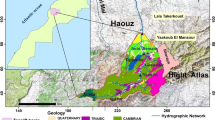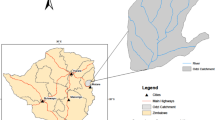Abstract
Soil erosion on arable land and on steep vineyards is a major problem in the state of Hesse (21,115 km²) in central Germany. The aim of a joint study between the Research Centre Jülich, the Hessian Agency for the Environment and Geology and the Hessian Ministry for the Environment, Energy, Agriculture and Consumer Protection was to delineate parcels which are severely affected by erosion and to identify sediment source areas. For this purpose, the ABAG, an adaptation of the USLE approach to German conditions, has been employed with the best available data sets on K-, C-, R- and LS-factor. Model results at the field scale show that soil losses in Hesse vary between <0.5 and >15 tonnes/hectare/year. The mean loss amounts to ca. 4.3 tonnes/hectare/year. The sediment delivery ratios for 450 sub-catchments range between 0.5 and 78% with a mean of 18%. Further analysis showed that LS- and C-factor are of highest sensitivity for the model output. Therefore, the effects of alternative algorithms or sources for LS- and C-factor on the results were assessed. An uncertainty analysis based on Gaussian error propagation and Monte Carlo simulation showed that the uncertainty of model results induced by input parameters is 1.7 tonnes/hectare/year or 34% of the mean annual soil loss. The model results are a good basis for further works concerning a soil erosion atlas and internet-based soil data viewer.








Similar content being viewed by others
References
Auerswald K (1987) Sensitivität erosionsbestimmender Faktoren. Wasser Boden 39:34–38
Auerswald K (2006) Germany. In: Boardman J, Poesen J (eds), Soil Erosion in Europe. 213–230
Beven K (2009) Environmental modelling: An uncertain future?. Abingdon and New York
Biesemans J, Van Meirvenne M, Gabriels D (2000) Extending the RUSLE with the Monte carlo error propagation technique to predict long-term average off-site sediment accumulation. J Soil Wat Cons 55(1):35–42
Chatfield C (1995) Problem solving: a statistician’s guide. 2nd edn, Boca Raton
De Vente J, Poesen J (2005) Predicting soil erosion and sediment yield at the basin scale: scale issues and semi-quantitative models. Earth Sci Rev 71:95–125
Desmet PJJ, Govers G (1996) A GIS procedure for automatically calculating the USLE LS factor on topographically complex landscape units. J Soil Wat Cons 51(5):427–433
Deumlich D, Frielinghaus M (1994) Eintragspfade Bodenerosion und Oberflächenabfluß im Lockergesteinsbereich. In: Werner W, Wodsak H-P (Eds), Stickstoff- und Phosphoreintrag in Fließgewässer Deutschlands unter besonderer Berücksichtigung des Eintragsgeschehens im Lockergesteinsbereich der ehemaligen DDR. Agrarspectrum, 22, Frankfurt/M
Evans R (2002) An alternative way to assess water erosion of cultivated land—field-based measurements: and analysis of some results. Appl Geogr 22:187–208
Frede H-G, Dabbert S (1999) Handbuch zum Gewässerschutz in der Landwirtschaft. 2nd edn, Landsberg
Fried JS, Brown DG, Zweifler MO, Gold MA (2000) Mapping contributing areas for stormwater discharge to streams using terrain analysis. In: Wilson JP, Gallant JC (eds) Terrain analysis—principles and applications. New York, pp. 183–203
Gottwald W (2000) Statistik für Anwender. Wiley-VCH, Weinheim
Guse B, Bronstert A, Rode M, Tetzlaff B, Wendland F (2007) Application of two phosphorus models with different complexities in a mesoscale river catchment. Adv Geosc 11:77–84
Hickey R (2000) Slope angle and slope length solution for GIS. Cartogr 29(1):1–8
Jäger S, Gündra H, Schroeder M, Dikau R (1993) Bodenerosionsatlas Baden-Württemberg. Heidelberg
Kinnell PIA (2001) Slope length factor for applying the USLE-M to erosion in grid cells. Soil Till Res 58:11–17
Mc Cool DK, Brown LC, Foster GR, Mutchler CK, Meyer LD (1987) Revised slope steepness factor for the universal Soil loss equation. Trans ASAE 30(5):1387–1396
Middleton MR (2003) Data analysis using microsoft excel. 3 rd edn
Mollenhauer K, Richtscheid P (2006) Hessen. In: Feldwisch N, Dankelmann E (eds), Bodenerosion durch Wasser—Bewertungsmethodik und Instrumente der deutschen Bundesländer. BVB-Materialien, 14:52–60
Mollenhauer K, Rathjen CL, Christiansen Th, Erpenbeck Ch (1990) Zur Erosivität der Niederschläge im Gebiet der deutschen Mittelgebirge, besonders im hessischen Raum. Schriftenr DVWK 86:79–162
Moore ID, Burch GJ (1986) Physical basis of the length-slope factor in the universal soil loss equation. Soil Sci Soc Am J 50:1294–1298
Murphree CE, Mutchler CK (1981) Verification of the slope factor in the universal soil loss equation for low slopes. J Soil Wat Cons 36:300–302
Nearing MA (1997) A single, continuous function for slope steepness influence on soil loss. SSSAJ 61:917–919
Pandey A, Chowdary VM, Mal BC (2007) Identification of critical prone areas in the small agricultural watershed using USLE. GIS and remote sensing. Water Resour Manag 21:729–746
Renschler CS, Harbor J (2002) Soil erosion assessment tools from point to regional scales—the role of geomorphologists in land management research and implementation. Geomorphology 47:189–209
Richtscheid P (1996) Die Karte der potentiellen Erosionsgefährdung Hessens und deren Umsetzung in der Bodennutzungspraxis. In: Thüringer Landesanstalt für Umwelt (ed), Vorsorge vor Bodenabtrag und Sanierung von Bodenschäden—Umsetzung von Grundlagenerkenntnissen in die Praxis des Bodenschutzes. Tagungsband, 18/96 Schriftenreihe der Thüringer Landesanstalt für Umwelt: 31–36
Risse LM, Nearing MA, Laflen JM, Nicks AD (1993) Error assessment in the universal soil loss equation. SSSAJ 57:825–833
Schmidt W, Seiffert S (2005) Sachsen. In: Feldwisch N, Dankelmann E (eds), Bodenerosion durch Wasser—Bewertungsmethodik und Instrumente der deutschen Bundesländer. BVB-Materialien, 14:102–115
Schwertmann U, Vogl W, Kainz M (1990) Bodenerosion durch Wasser—Vorhersage des Abtrags und Bewertung von Gegenmaßnahmen. 2nd edn, Stuttgart
Tarboton DG (1997) A new method for the determination of flow directions and upslope areas in grid digital elevation models. Water Resour Res 33(2):309–319
Tetzlaff B (2006) Die Phosphatbelastung großer Flusseinzugsgebiete aus diffusen und punktuellen Quellen. Forschungszentr. Jülich, R. Umwelt/Environment 65
Tetzlaff B, Wendland F (2007) Modelling P-fluxes from diffuse and point sources in heterogeneous macroscale river basins using MEPhos. In: Förstner U, Westrich B (eds) Sediment dynamics and pollutant mobility in rivers. Series Environmental Science, Berlin
Tetzlaff B, Kreins P, Kunkel R, Wendland F (2007) Area-differentiated modelling of P-fluxes in heterogeneous macroscale river basins. Water Sci Technol 55(3):123–131
Tetzlaff B, Kuhr P, Wendland F (2009a) A new method for creating maps of artificially drained areas in large river basins based on aerial photographs and geodata. Irrig Drain 58(5):569–585
Tetzlaff B, Kuhr P, Vereecken H, Wendland F (2009b) Aerial photograph-based delineation of artificially drained areas as a basis for water balance and phosphorus modelling in large river basins. Phys Chem Earth 34:552–564
Tetzlaff B, Vereecken H, Kunkel R, Wendland F (2009c) Modelling phosphorus inputs from agricultural sources and urban areas in river basins. Environ Geol 57:183–193
Wang G, Hapuarachchi P, Ishidaira H, Kiem AS, Takeuchi K (2009) Estimation of soil erosion and sediment yield during individual rainstorms at catchment scale. Water Resour Manag 23:1447–1465
Wischmeier WH (1976) Use and misuse of the universal soil loss equation. J Soil Wat Cons 31:5–9
Wischmeier WH, Smith DD (1965) Predicting rainfall-erosion losses from cropland east of the Rocky-Mountains. Agriculture Handbook 282
Zehe E, Becker R, Bardossy A, Plate E (2005) Uncertainty of simulated catchment runoff response in the presence of threshold processes: role of initial soil moisture and precipitation. J Hydrol 315:183–202
Author information
Authors and Affiliations
Corresponding author
Rights and permissions
About this article
Cite this article
Tetzlaff, B., Wendland, F. Modelling Sediment Input to Surface Waters for German States with MEPhos: Methodology, Sensitivity and Uncertainty. Water Resour Manage 26, 165–184 (2012). https://doi.org/10.1007/s11269-011-9911-1
Received:
Accepted:
Published:
Issue Date:
DOI: https://doi.org/10.1007/s11269-011-9911-1




